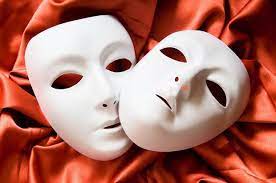Finding Your Truth Through Acting’s Lens
Acting techniques developed for the stage—but with practical wisdom for life—offer methods to better understand and express our true selves, connect sincerely with others, and recognize the social dynamics surrounding us. Blending concepts from the emotionally-immersive process of method acting, the spontaneous presence of Meisner technique, the psychologically-rich approach of Adler’s training, and the physically-freeing Viewpoints practices allows actors—and anyone—to explore expansive, honest selfhood beyond one-dimensional roles; truly attune to new situations and people by moving beyond assumptions; unearth inner motivations to consciously fuel authentic actions; and raise awareness of the invisible social architecture influencing all human relationships and power.
Method acting reminds us that genuine understanding and essential self-knowledge come from honestly working through the deep emotions and formative experiences of our past that inform who we are at present. Actors following the method strive to connect their character’s experiences and backstory to the emotional memories of their own pivotal life events. By linking childhood impressions, pains and joys to current motivations, method actors hope to bypass surface, inauthentic displays and let a fully-committed performance flow truthfully from the emotional core accessed.
While creatively plumbing emotional depths may seem the work of artists alone, all individuals can benefit from turning method acting’s lens on their own lives. We all have moments from growing up that shaped who we became: the music we first fell in love with, the excitement of a childhood trip, moving somewhere new, first heartbreaks, anger from bullying or neglect. Our current persona—our attitudes, reactions, openness or guardedness with family and friends—often builds directly on these remembered emotions of yesterday. Facing our experiences and shaping forces head-on as a method actor would deepens our self-understanding, clarifies motivations that may elude our conscious thought, and illuminates hidden cathartic connections between past and present that can let us live and act from a place of greater wisdom and honesty. Emotion creates connection.
While method actors dive backward in time to sculpt a role, Sanford Meisner trained performers to simply be fully in the present. Key Meisner exercises involve listening completely to your scene partners, reacting honestly instinctively instead of planning a “performance,” and using trained observation and attention to pick up on subtle behavioral cues that inform spontaneous exchanges.
Practicing this kind of radically honest, instinct-based communication can benefit everyone from sales meetings to student mentorships. Rather than anxiously fixating on saying the “right thing” or projecting rehearsed images, simply embrace conversing comfortably through authentic presence—calm, eye contact, and opening senses to what others emit. Forget about judging. This builds connection organically by letting wisdom and responses ripple up based on friendship or compassion rather than ego. Dropping habit for presence helps us perceive people accurately instead of through distorting assumptions. It offers suffering peers understanding through undistracted ears. Like Meisner actors, receptive being melts divides.
While Meisner preaches reacting honestly in-scene, Stella Adler believed the richest acting emerges from fully envisioning a character’s background to clarify why they do what they do. An Adler actor extensively researches and imagines details about their role’s upbringing, hometown people and surroundings, economic class experiences, early ambitions and hardships faced to build a penetrating psychological foundation for organic, grounded choices. They create invisible history through purposeful imagination to make visible truthful action.
We too can harness motivation by revisiting what built us. Childhood neighborhood settings, cultural traditions passed down, family stories affecting parents before us contain wealths of insights on who we became—and can still be. Imagining the forces which may guide friends and even newsmakers opens understanding. Creatively speculating on the shaping influences behind troubling behaviors plants seeds of forgiveness. This “empathetic character study” creates psychological texture granting clearer sight about ourselves and fellow players stepping on life’s stage.
Finally, while method acting looks inward, Meisner outward, and Adler behind for sources of inspiration, Mary Overlie’s Viewpoints training focuses performers perceptually into the stage itself as communally occupied space ripe with expressive potential. Viewpoints teachers see physical positioning between actors as layered with energies: an interplay of distances, angles between bodies in architectural arrangements implying relationships, intentions or power centralities before a word’s been uttered. Practitioners attune towards space as a live, dynamic field that can shape improvised choreography.
Observing spaces this way in daily settings—from classrooms to board meetings— similarly excavates how unspoken communication patterns take form: clustered allies, tense stand-offs between opposing viewpoints, openings for bridging divides. Internalizing these invisible spatial energies and architectures builds conscious awareness. How can arrangements shift to promote shared goals? Much rigidity loosens. With bird’s-eye sociological sight, we grasp community bonds awaiting activation through bold, compassion-guided spatial reorganization. Let structural imagination inspire agency.
Altogether, incorporating method acting’s evocative personal excavation, Meisner’s unfiltered instincts, Adler’s world-expanding speculation and Viewpoints’ structural lens offers everyday folks, not solely performers, a broader toolkit for growth. We better know our emotional topography and formative experiences to show up honestly. We approach others through presence not stagnant judgments. We proactively motivate by revisiting inspirations. And we consciousness-raise around the relational structures governing all. Moving through life, not as passive audience members with prescribed identities but empowered actors richly exploring our potential, we are equipped to open self-knowledge, bonds across divides and previously unimagined opportunities alloying self-actualization and community uplift. Let these approaches inspire your best work yet.

